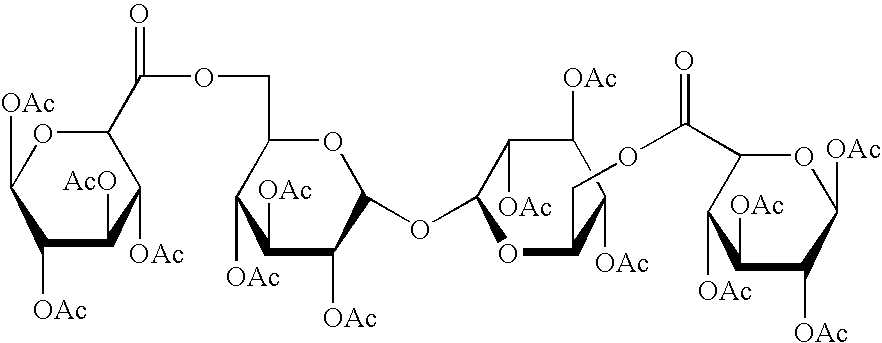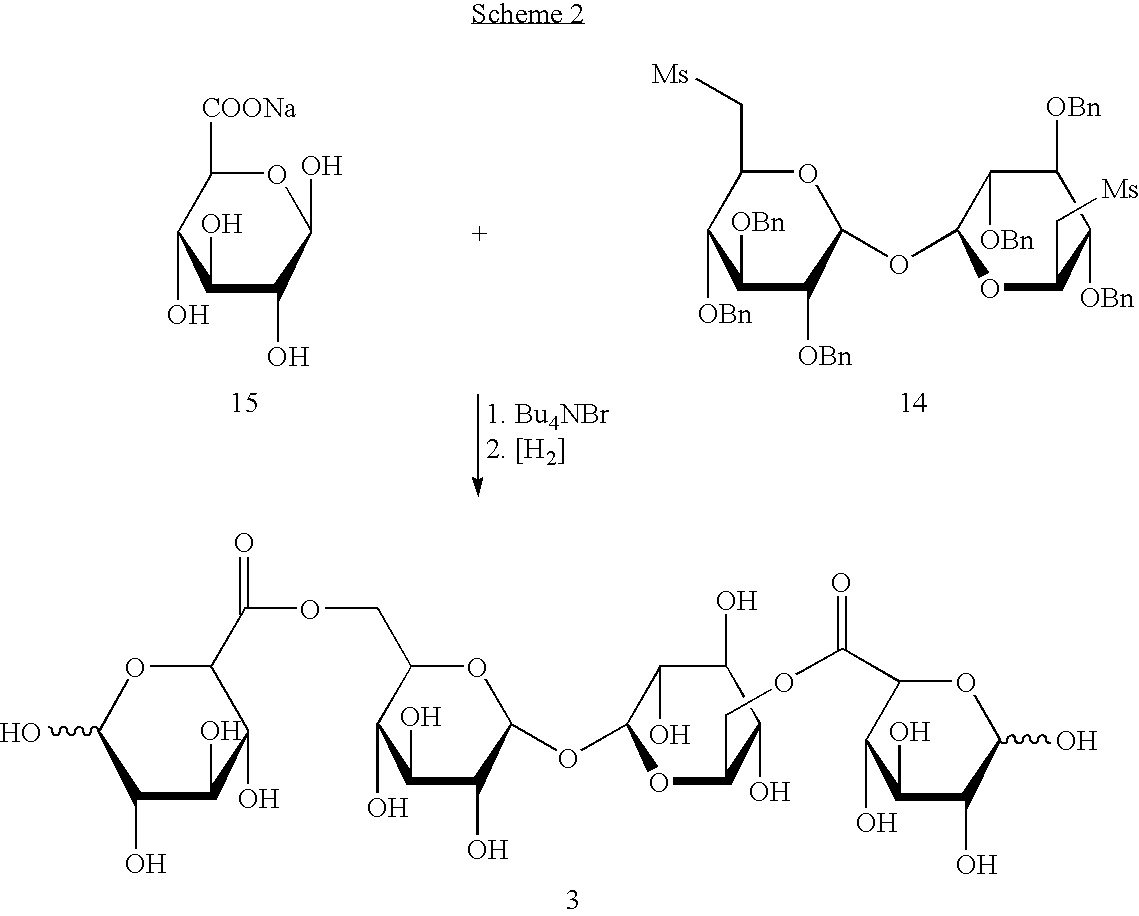Derivatised carbohydrates and their use in solid delivery systems
a technology of derivatised carbohydrates and solid-state delivery, which is applied in the direction of esterified saccharide compounds, applications, oligosaccharides, etc., can solve the problems of many drugs not suitable for transdermal delivery, physical discomfort, and risk of infection
- Summary
- Abstract
- Description
- Claims
- Application Information
AI Technical Summary
Benefits of technology
Problems solved by technology
Method used
Image
Examples
example 1
Ditrityl Trehalose
[0068]Trehalose dihydrate is briefly ground with a mortar and pestle before being dried at 2 millibar and 75° C. for twelve hours. The expected weight loss is 9.5%. The material is checked by adding 1 g to 7 ml pyridine with stirring. This rapidly gives a clear solution.
[0069]Anhydrous amorphous trehalose (100 g, 2.92×10−1 mol) is dissolved in pyridine (400 ml) and trityl chloride (170 g, 6.10×10−1 mol) is added slowly and the solution stirred at 40° C. for 24-36 hr, when tlc (4:1:1 EtOAc:MeOH:water) showed the reaction to be complete. Most of the pyridine is then removed under reduced pressure before the resulting syrup is poured into water (1 l) with stirring. The pale orange precipitate is collected by filtration, thoroughly washed with water (500 ml) and then dried under reduced pressure (10-15 mm Hg) at 70° C. Hot methanol (500 ml, 60° C.) is added to the solid and the slurry stirred for 5 min and filtered to collect the product. The solution contains mostly s...
example 2
4,6:4′,6′-Dibenzylidene Trehalose
[0081]Anhydrous amorphous trehalose (200 g, 0585 mol) is added with vigorous stirring to a mixture of benzaldehyde (750 ml) and freshly ground zinc chloride (350 g). The mixture is stirred for 4-5 days at room temperature. Water (750 ml) and light petroleum (750 ml) are then added with stirring. The resulting white precipitate is collected, washed with water (250 ml) and light petroleum (250 ml) to give 4,6:4′,6′-dibenzylidene trehalose (180-225 g, 60-84%) as a white solid. This is used without further purification.
[0082]Mp 196-99° C. δ (CD3OD) 7.48 (4H, cm, ArH), 7.32 (6H, cm, ArH), 5.55 (2H, s, PhCH), 5.11 (2H, d, H-1,1′), 4.21 (2H, dd, H-6a,6a′), 4.10 (2H, dt, H-5,5′), 4.02 (2H, t, H-4,4′), 3.71 (2H, t, H-6b,6b′), 3.62 (2H, dd, H-2,2′), 3.47 (2H, t, H-3,3′)
4,6:4′,6′-Dibenzylidene-2,3:2′,3′-Tetraisobutyroyl Trehalose
[0083]Dibenzylidene trehalose (100 g, 0.192 mol) is dissolved with stirring in pyridine (200 ml) and cooled in water. Isobutyroyl chlo...
example 3
[0090]This Example illustrates a formulation of the invention, using cyclosporin as a model lipophile. A formulation comprising cyclosporin and the OED compound of Example 1 was prepared from a dicloromethane solution containing cyclosporin (20% + / −OED (80%) using a Buchi 191 Mini laboratory Spray Dryer. The product was initially assessed for surface morphology, particle size, particle size distribution, dispersion and in vitro release into selected aqueous media.
[0091]Volume particle size and distribution measured using an Aerosizer with Aerodisperser (API Aerosizer, Amherst Process Instrument Inc., USA) (shear force: peak, de-agglomeration: high, feed rate: low pin vibration: on and running time 180 seconds) showed that the formulation had a particle size of less than 3 μm, with the majority of particles having a distribution between 1 to 2 μm. Glass transition was detected using a differential scanning calorimeter (Perkin Elmer DSC 7, 0-200° C. at 10° C. / minute) and no crystallin...
PUM
| Property | Measurement | Unit |
|---|---|---|
| Temperature | aaaaa | aaaaa |
| Temperature | aaaaa | aaaaa |
| Temperature | aaaaa | aaaaa |
Abstract
Description
Claims
Application Information
 Login to View More
Login to View More - R&D
- Intellectual Property
- Life Sciences
- Materials
- Tech Scout
- Unparalleled Data Quality
- Higher Quality Content
- 60% Fewer Hallucinations
Browse by: Latest US Patents, China's latest patents, Technical Efficacy Thesaurus, Application Domain, Technology Topic, Popular Technical Reports.
© 2025 PatSnap. All rights reserved.Legal|Privacy policy|Modern Slavery Act Transparency Statement|Sitemap|About US| Contact US: help@patsnap.com



